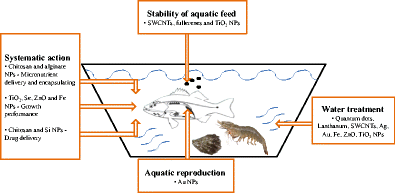Effects of nanoparticles in species of aquaculture interest |
| |
| Authors: | Kheyrollah Khosravi-Katuli Ermelinda Prato Giusy Lofrano Marco Guida Gonçalo Vale Giovanni Libralato |
| |
| Institution: | 1.Department of Fishery,Gorgan University of Agricultural Sciences and Natural Resources,Gorgan,Iran;2.Institute for the Coastal Marine Environment, National Research Council (CNR IAMC),Taranto,Italy;3.Department of Chemistry and Biology,University of Salerno,Salerno,Italy;4.Department of Biology,University of Naples Federico II, Complesso Universitario di Monte S. Angelo,Naples,Italy;5.Centro de Quimica Estrutural, Instituto Superior Tecnico,Universidade de Lisboa,Lisbon,Portugal;6.Department of Molecular Genetics,University of Texas Southwestern Medical Center,Harry Dallas,USA |
| |
| Abstract: | Recently, it was observed that there is an increasing application of nanoparticles (NPs) in aquaculture. Manufacturers are trying to use nano-based tools to remove the barriers about waterborne food, growth, reproduction, and culturing of species, their health, and water treatment in order to increase aquaculture production rates, being the safe-by-design approach still unapplied. We reviewed the applications of NPs in aquaculture evidencing that the way NPs are applied can be very different: some are direclty added to feed, other to water media or in aquaculture facilities. Traditional toxicity data cannot be easily used to infer on aquaculture mainly considering short-term exposure scenarios, underestimating the potential exposure of aquacultured species. The main outputs are (i) biological models are not recurrent, and in the case, testing protocols are frequently different; (ii) most data derived from toxicity studies are not specifically designed on aquaculture needs, thus contact time, exposure concentrations, and other ancillary conditions do not meet the required standard for aquaculture; (iii) short-term exposure periods are investigated mainly on species of indirect aquaculture interest, while shrimp and fish as final consumers in aquaculture plants are underinvestigated (scarce or unknown data on trophic chain transfer of NPs): little information is available about the amount of NPs accumulated within marketed organisms; (iv) how NPs present in the packaging of aquacultured products can affect their quality remained substantially unexplored. NPs in aquaculture are a challenging topic that must be developed in the near future to assure human health and environmental safety. |
| |
| Keywords: | |
| 本文献已被 SpringerLink 等数据库收录! |
|

